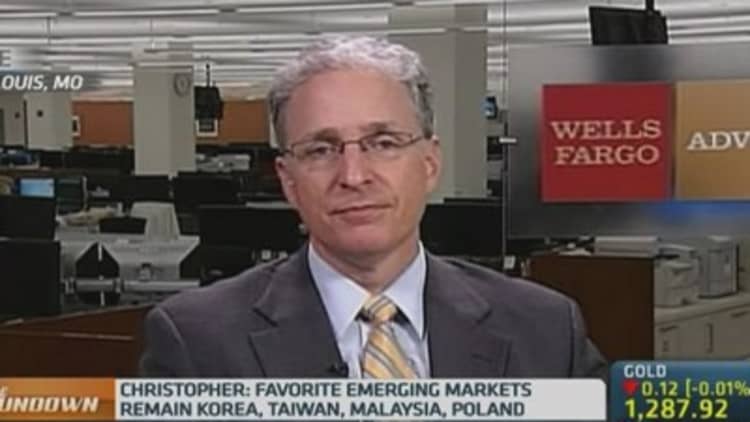China is quietly pushing back its loose timetable to make the yuan freely convertible, policy insiders say, as authorities fear removing capital controls too soon could unleash damaging speculative flows that will make it harder to reshape the economy.
There has never been a hard target date for a freely traded yuan, although the central bank had outlined a goal of making it 'basically convertible' by 2015. That rhetoric has been toned down recently, and now analysts are looking to 2020, a deadline implied by the government's reform agenda set out last November.
Heading off a sharp slowdown in growth and domestic reforms, such as fixing the fiscal system to rein in debt, overhauling banks and state conglomerates will be done first, according to economists at top government think-tanks and policy advisers.
"Opening up the capital account will be the last of reforms. We need to improve domestic financial markets and improve legal systems first," said an influential former central bank researcher who now works for the government.
"That was the reason why other emerging markets were hit by speculators," said the researcher, who requested anonymity.
Read MoreChina economy grows 7.5% in the second quarter
Hot money fears
While the yuan is already convertible under China's current account, the broadest measure of trade in goods and services, the capital account, which covers portfolio investment and borrowing, is still closely managed by Beijing.
Nearly one-fifth of China's trade is now settled in yuan, up from less than 1 percent in 2009, when internationalization was seen as a way for firms to reduce currency risks and also to challenge the U.S. dollar's role as the key reserve currency.
As the yuan is increasingly used in trade and investment, as well as in offshore yuan trading hubs, investors have sought to skirt capital controls by exploiting various loopholes - some of which could remain until the currency is fully liberalized.
The government keeps a tight grip on speculative flows, but under the yuan internationalization scheme, firms can move their funds across the border via trade settlements.
One method is to borrow funds cheaply overseas and move them into China to profit from China's higher interest rates and, at least until earlier this year, a view the yuan would steadily rise. The funds are later repatriated.

These arbitrage trades intensified in early 2013 as some firms falsified export invoices to funnel cash, mainly from Hong Kong, into the mainland, inflating export figures and triggering an official crackdown last June.
"The full opening of the capital account is the most sensitive and risk-prone reform among all reforms," said Yu Yongding, an influential economist at the Chinese Academy of Social Sciences, a top government think-tank, who thinks the timetable for convertibility has been quietly pushed back.
"Once China abolishes capital controls, China's financial system will be fully exposed to the powerful gunfire of the international speculative capital," Yu, a former central bank adviser, wrote in the July edition of the Studies of International Finance.
Read MoreGlobal firms becoming keen on using yuan
It's hard to gauge the size of hot money flows. One measure from official data shows sharp swings this year, which is likely to have further worried policymakers who are focused on vulnerabilities at a time of debt defaults and rising bad loans.
China had a $28.6 billion surplus in trade and direct investment in the first quarter, while banks bought a net $159.2 billion of foreign exchange, an excess of $130.6 billion, Guan Tao, head of the international payments division of the State Administration of Foreign Exchange told reporters.
But the tide turned in the second quarter, with the combined trade and investment surplus jumping to $94.3 billion and banks' net foreign exchange purchases falling to $29 billion, implying a net outflow of $65.3 billion.
Small steps
"They are taking small reform steps to avoid making mistakes - it could trigger bubbles in the economy if you cannot handle well," said Zhao Yayun, senior economist at Chongyang financial institute of Renmin University.
Volatile fund flows have previously created difficulties for policymakers. A sudden capital flight around the middle of last year worsened an inter-bank market crunch, and the central bank was seen intervening to weaken the yuan earlier this year to hit speculators and end the view the currency was a one-way bet.
China does have a potential defense against hot money outflows that no other country can match - foreign exchange reserves of $3.99 trillion at the end of June.
Read MoreFrom weak to strong: China's yuan changes track
Reforms will still happen, but they are expected to be piecemeal and slow rather than a "big bang" as Beijing tries to remake the economy and put it on a lower but more sustainable growth trajectory.
The new free-trade zone in Shanghai will be used to test currency reforms while insulating the broader economy until policymakers are confident of their impact.
"We cannot open up the capital account for the sake of pushing yuan internationalization," said Guo Tianyong, an economist at Central University of Finance and Economics in Beijing.
"We must assess the economy's ability to cope with risks."

